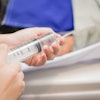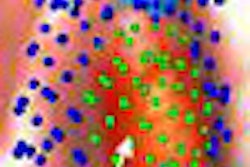Finding polyps may be a tough job, but radiologists aren't any better at it than radiographers, according to the results of a new virtual colonoscopy study.
"The origins of interobserver variability are not completely understood, but high volumes of data and low disease prevalence, which lead to reviewer fatigue, may play a role," wrote Dr. Sebastiaan Jensch and his team from the department of radiology at the Academic Medical Center in Amsterdam. "These problems are of particular concern in screening, in which large number of patients without symptoms are examined" (American Journal of Roentgenology, March 2007, Vol. 188:3, pp. W249-W255).
More advanced computer-aided detection (CAD) systems and double reading of studies, as is done in mammography, are both potential solutions. CAD may be years away from routine use, however, and double interpretation is expensive and time-consuming for the radiologists on duty. Hence the idea of deploying "trained medical personnel as second reviewers," explained Jensch and colleagues.
"The aim of the study was to investigate the reviewer performance of two trained radiographers in comparison with that of two radiologists in the evaluation of CTC (CT colonography or virtual colonoscopy [VC]) examinations of 150 patients by comparing the sensitivity and specificity of CTC in polyp detection with those of the reference standard, optical colonoscopy," he wrote, along with Dr. Rogier van Gelder, Dr. Jasper Florie, and colleagues.
In the study, four observers (a radiologist, a radiologist in training, and two radiographers) interpreted 145 datasets using a primary 3D method. The consecutive patients all had increased risk of colon polyps or cancer.
All patients underwent full bowel cleansing with 4-6 L of polyethylene glycol (Klean-Prep, Helsinn Birex Pharmaceuticals, Dublin) on the day before the exam. Butylscopolamine bromide (20 mg of Buscopan, Boehringer Ingelheim, Ingelheim, Germany) or glucagon hydrocholoride (1 mg of Glucagen, Novo Nordisk, Copenhagen) was administered as an antispasmodic, and colons were manually insufflated with a mixture of room air and 13.4% CO2, the authors reported.
CT images were acquired on a four-slice scanner (Mx8000, Philips Medical Systems, Andover, MA) at 4 x 2.5-mm collimation, 120 kVp, 0.75-second rotation, pitch of 1.25, slice thickness of 3.2 mm, and reconstruction interval of 1.6 mm.
The tube current was reduced from 100 mAs over the course of the study when it became clear that "substantial radiation dose reduction did not impair sensitivity or specificity," the authors wrote. Depending on body habitus, mAs ranged from 40-70.
"Two research fellows not involved in interpreting the findings matched CT colonographic and colonoscopic (reference standard) findings," the group explained. Both the size and location had to correspond with CTC to be considered a match.
The radiologist had nine years of experience and had interpreted about 9,000 abdominal exams, while the radiologist in training had performed about 50 CTC cases, and both had evaluated about 150 datasets as part of a larger virtual colonoscopy study.
The third and fourth readers were radiographers with about five years of experience each. Both had read about 50 CTC exams before the study, and evaluated about 20 complete VC datasets as training for it. The readers employed a primary 3D interpretation method (EasyVision, Philips) with 2D problem-solving.
The colonoscopic results revealed a total of 317 polyps, including 60 polyps 6 mm or larger in 26 patients, and 31 polyps 10 mm or larger in 18 patients, the group reported.
"No statistically significant differences were found in detection rates between radiologists and radiographers," they wrote. "Sensitivities for patients with a lesion of any size (66% for radiologists versus 65% for radiographers), ≥ 6 mm (81% versus 87%), and ≥ 10 mm (both 78%) were similar for all observers."
On a per-polyp basis, detection rates were equivalent for radiologists and radiographers "regardless of polyp size (47% versus 40% overall) for lesions ≥ 6 mm (71% versus 65%), and for lesions ≥ 10 mm (69% versus 66%)," the group reported. Finally, the mean specificities between radiologists and nonradiologists were similar for all patient categories: those without lesions (31% versus 30%), those without lesions 6 mm and larger (71% versus 67%), and those without lesions 10 mm and larger (93% versus 93%).
Because of the importance of identifying patients who require optical colonoscopic follow-up at virtual colonoscopy, per-patient sensitivity was used as the main outcome parameter. All four readers correctly identified 14 of the 18 (78%) patients with at least one polyp 10 mm or larger, and "the same four patients with large polyps were missed by all observers," the authors wrote.
Two earlier studies, by Bodily et al and the ESGAR multicenter trial still in press, have reported broadly similar results, although experienced radiologists have performed faster and slightly more accurately than nonradiologists. The present study differed in its use of a primary 3D reading method, though radiologists still read the studies a little faster than the "highly motivated" radiographers (14 versus 18 minutes), Jensch and his colleagues noted.
"It is important to understand, however, that all reviewers were scheduled free from clinical work, and no time limit was imposed," they added. "These data therefore cannot be extrapolated to a production environment, and we do not know whether radiographers can perform as well in daily routine."
Among the limitations of the study were the small number of reviewers and a short learning curve of only 20 cases for the radiographers. And by the end of the study, the radiologists had almost twice as much reviewer experience as the radiographers, the team added. In addition, a balloon-tipped tube used to inflate the colon obscured a large polyp for all readers, and there was no fecal tagging.
The results suggest that "dedicated radiographers trained in interpretation of CTC examinations can achieve accuracy comparable to that of radiologists in the evaluation of CTC," Jensch and his colleagues concluded. "The results imply that deployment of a radiographer as a reviewer in CTC is acceptable. This finding is of particular interest in double-interpretation screening."
By Eric Barnes
AuntMinnie.com staff writer
March 19 2007
Related Reading
Missed colorectal cancer rates higher with office-based colonoscopy, February 23, 2007
Gastroenterologists plan to perform VC, January 25, 2007
VC CAD helps junior readers catch up, May 4, 2006
VC experts have an edge over less experienced readers, March 8, 2005
Training key to VC performance, but how much is anyone's guess, February 8, 2005
Copyright © 2007 AuntMinnie.com




















